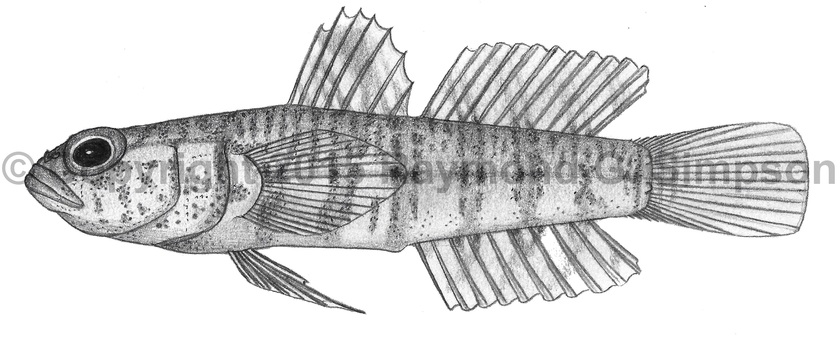
Common Name
Fisher's Goby
Year Described
Herre, 1942
Identification
Dorsal Fin: VII, 11-12
Anal Fin: 10
Pectoral Fin: 17-18
Caudal Fin: 17 segmented rays
Vertebrae: 11+16= 27 (total)
Body stout and tapering posteriorly. Eye relatively large. Dorsal fin with anterior two spines not elongate and last two spines more spaced than the first five. Pelvic fin rays branched with the last shorter than first spine. Pelvic fins not fused. One anal-fin pterygiophore anterior to the first haemal spine. Papillae rows 5i and 5s are connected. Cephalic lateralis pores absent. Body naked. Belly unscaled. Basicaudal scales present.
Color
Body variable in pattern. Head pale orange and body pale yellowish. There are ~6 body brown bands and/or saddles that are often broken by a thin pale interspace on each band. There are often faint midbody blotches when bands are reduced to saddles. Brown spots and melanophores over rest of body. Spots on head become bright orange, and often form lines or incomplete bands. Orange hue continues posteriorly on belly to anal fin. Brown melanophores mixed in with orange spotting, especially around eye, snout, and top of head. First dorsal yellow with dense brown melanophores and a broad clear margin. Second dorsal with oblique bands of yellow-brown and a thinner clear margin. Caudal fin with vertical bands of yellow-brown. Anal fin with dark brown melanophores and few orange spots basally. Pelvic and pectoral fins clear. Eye brown.
Size
Maximum size to 22mm SL.
Habitat
Taken on shallow reefs and deep reefs from 2-82m.
Range
The Bahamas to northern South America and Brazil. Holotype taken off of the Barbados.
References
Hastings, P.A. & S.A. Bortone. 1981. Chriolepis vespa, a new species of gobiid fish from the northeastern Gulf of Mexico. Proceedings of the Biological Society of Washington v. 94 (no. 2): 427-436.
Tornabene, L., J.L. Van Tassell, R.G. Gilmore, D.R. Robertson, F. Young, & C.C. Baldwin. 2016. Molecular phylogeny, analysis of character evolution, and submersible collections enable a new classification of a diverse group of gobies (Teleostei: Gobiidae: Nes subgroup), including nine new species and four new genera. Zoological Journal of the Linnean Society.
Other Notes
This species has a range of character states that are typical of separate genera described in Tornabene et al. (2016). This includes the branched pelvic rays of Pinnichthys, the basicaudal scales of Varicus, and the unique naked body absent in the Varicus/Pinnichthys clades. Material investigated appears to be paraphyletic and widespread in the Caribbean and off Brazil. The identification of this species here is based on the original description for Chriolepis fisheri.